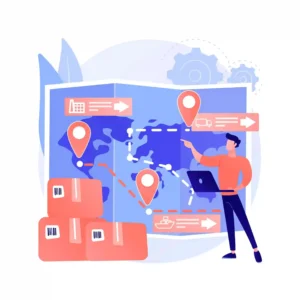Internet of Things
When You Connect Your Business With IoT, The Opportunities Are EndlessBring your business together in new insightful ways with the Internet of Things (IoT) – from increasing process efficiencies to delivering better customer experiences to generating new revenue steams. Preferred IoT Consulting Partner for Enterprises Globally Our team helps Enterprises build Systems of Intelligence using IoT Platform to extract real-time insights from their business. We leverage our IoT services expertise to connect thousands of physical assets with Cloud, Mobile devices & backend ERPs/CRMs. Thus, enabling them to harness their enterprise data for creating differentiated competitive advantage, higher business value & highly improved customer satisfaction. Connected Enterprises with IoT Create real-time interactions with your customers, field force and physical assets Anytime, Anywhere Data access Mobilize your Enterprise, making it securely accessible to employees & consumers Accelerate Business outcomes Use your data to derive business intelligence, enabling enhanced decision making Industry Focused IoT App Development Services Upgrade from ‘Go Digital’ to ‘Being Digital’ with our industry focused Internet of Things services Retail Add new revenue channels, deliver superior customer experience & optimize Supply Chain Management with IoT development services for retail. Retail Supply Chain Achieve competitive advantage & magnify profits in retail supply chain by optimizing customer retail experience at every square foot of brick & mortar stores. Smart Shelves Real-time visibility of stock levels, shelf life of perishable goods & proactive reorder alerts at all levels of manufacturing, distribution & supply Delivery Operations Redraw point-to-point delivery mechanisms with smart sensors that reduce carriage distance, delivery span & improve fuel efficiency. Warehouse Automation Build automated warehouses that utilizes data from embedded sensors in equipment & bins to optimize stock movement & product assembly. Interactive digital signage screens Set up digital signage in the store to attract visitors and help them navigate through your products, discounts, and loyalty programs. IoT-enabled beacons For retailers, beacons can prove to be an effective advertising tool that boosts the power of personalization, provides insightful data and increases app engagement and retention. Manufacturing Breed a whole new range of heavy machinery that work with IoT solution enabled intelligence. Product Asset Management Prevent wastage of inventory, energy and man hours through predictive product asset management that sustains best health of assets throughout the production cycle. Connected Factory Refresh your factory operations by integrating embedded controller technology consisting of sensors & actuators for remote equipment management, better workforce safety & productivity. Performance Optimization Build an ecosystem of connected machinery that work together in collaborative environment to achieve automated production & quicker production cycles at same or reduced cost levels Safety / Security Improve employee safety, reduce toxic byproduct production and control several other manufacturing safety issues through sensors that work at levels of the manufacturing unit. Construction Imbibe IoT technology grounded management into buildings for a better living experience. Inventory Replenishment In a business where time is of essence, ensure that your equipment and construction inventory is always at optimal levels with next-gen IoT sensors. Remote Operation Connect, control & manage critical construction equipment from a unified control base. Monitor key metrics like temperature, pressure, vibration, etc. for corrective actions. Tools & Equipment Tracking Manage & measure health and vital stats of equipment scattered across vast expanse of construction sites on a real-time basis using sensor based geopositioning Equipment Servicing & Repair Schedule maintenance, predict downtimes and remedy performance inconsistencies by analysing & consolidating a deluge of sensor data created by all equipments. Logistics Transport and logistics with integrated IoT for sensing and shaping demand and building & adapting supply chain that will result in improved capacity, efficiency, reliability & lower cost. Fleet Management & Monitoring Optimize fleet management & vehicle monitoring through onboard sensors that collect onroad information about vehicle & driver behaviour. Connected Vehicles Build Vehicle of the future that can merge into their immediate surroundings by reading & transmitting data through sensors. Remote Vehicle Diagnostics Empower cognition for vehicles that can remotely diagnose mechanical stats, comfort settings & entertainment consoles Vehicle Tracking In-vehicle hardware & software embedment that give real-time insights on vehicle movement, location, health stats & other contextual data. Energy Rethinking energy management, billing and asset maintenance with internet of things development for Energy. Smart Metering Smart metering that will eliminate manual inaccuracies in billing this rewarding cost savings for customers. Also prepares energy grids for peak time usage through meter data capture. Asset Performance Management Preset conditions based maintenance that help reduce asset wear & tear, energy wastage & improves energy generation, transmission & distribution across vast geographical expanses. Energy Distribution Connect, control & manage complex energy grids from a single console with a network of connected devices. Predict peak times, prepare for downtimes and sustain consistent energy delivery. Industries Manufacturing Sandvik Cormorant combines human and digital intelligence into a predictive analytics solution Hospitality Technology Specialists For Food Service Enterprises, Globally. We enable the use of Enterprise mobility.. Transport & Logistics A premier Logistics service provider goes cutting-edge with IoT based Fleet management solution to delight its customers Report IoT and Analytics: Better Manufacturing Decisions in the era of Industry 4.0. Increasingly, Best-in-Class firms are.. READY TO TAKE THE NEXT STEPS WITH TRIDENT’S IOT SOLUTIONS Contact us today to schedule a quick chat about your project, or sign up for one of our monthly demos! Request For Demo
Internet of Things Read More »




